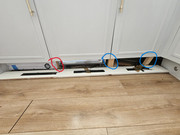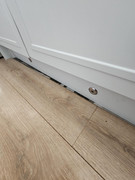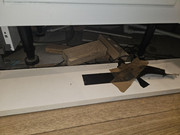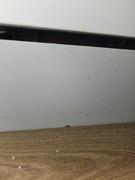Ideas to repair kitchen plinth?
Discussion
I have recently moved into a new home. It appears that the previous owners may have cut a few corners and there appears to be some bodgery.
I am certainly no carpenter / DIY expert and wondered if anyone had some relatively easy to implement ideas which would resolve the problem (aside from hiring someone! )
)
The problem: in the kitchen we have some integrated appliances and built in cupboards. Below the cupboards is an MDF plinth which has some lighting wired into it (note the evidence of quality workmanship by the presence of electrical tape and parcel tape ). The plinth does not appear to fit very well and was leaning in place. When brushed, or the cupboard opened - the vibration will cause the plinth to fall. I would like to make this more secure so it looks tidy.
). The plinth does not appear to fit very well and was leaning in place. When brushed, or the cupboard opened - the vibration will cause the plinth to fall. I would like to make this more secure so it looks tidy.
I don't think we can (or should) glue / nail it into place as at some point we may require access to the integrated appliances.
Picture 1: On the right hand side are 2 blocks of wood (circled blue) which are not attached to anything placed in front of supports for the cupboard. I also have a small strip (circled red) which I could use for attaching.

Picture 2: If I push the plinth up against the circled red area it leaves a gap between the floor and plinth which isn't very cosmetically pleasing.

An idea I had was to drill holes through the plinth and use wood screws and attach to the blocks. The screws could always be removed if needed. However, it only appears there is one fixed point for attaching to anyway. I would still have the gap issue between floor and plinth.
A slightly more complicated idea is to insert a thin panel between the plinth and the blocks to give a bit more thickness acting as a buffer to avoid the gap between floor and plinth.
Any better ideas / suggestions to try improve the mess which was left?
I am certainly no carpenter / DIY expert and wondered if anyone had some relatively easy to implement ideas which would resolve the problem (aside from hiring someone!
 )
) The problem: in the kitchen we have some integrated appliances and built in cupboards. Below the cupboards is an MDF plinth which has some lighting wired into it (note the evidence of quality workmanship by the presence of electrical tape and parcel tape
 ). The plinth does not appear to fit very well and was leaning in place. When brushed, or the cupboard opened - the vibration will cause the plinth to fall. I would like to make this more secure so it looks tidy.
). The plinth does not appear to fit very well and was leaning in place. When brushed, or the cupboard opened - the vibration will cause the plinth to fall. I would like to make this more secure so it looks tidy. I don't think we can (or should) glue / nail it into place as at some point we may require access to the integrated appliances.
Picture 1: On the right hand side are 2 blocks of wood (circled blue) which are not attached to anything placed in front of supports for the cupboard. I also have a small strip (circled red) which I could use for attaching.

Picture 2: If I push the plinth up against the circled red area it leaves a gap between the floor and plinth which isn't very cosmetically pleasing.

An idea I had was to drill holes through the plinth and use wood screws and attach to the blocks. The screws could always be removed if needed. However, it only appears there is one fixed point for attaching to anyway. I would still have the gap issue between floor and plinth.
A slightly more complicated idea is to insert a thin panel between the plinth and the blocks to give a bit more thickness acting as a buffer to avoid the gap between floor and plinth.
Any better ideas / suggestions to try improve the mess which was left?
g4ry13 said:
Any better ideas / suggestions to try improve the mess which was left?
Quick and dirty method may be to stick some window packers (or similar spacers) to those blocks to get the in/out right, and then stick the panel on with some sillicone.Easy to peel the board off for servicing later if necessary.
Not an elegant solution, but easy and functional.
The normal solution would be to have plinth clips that clip around the unit legs. However yours are bits of wood.
I would buy some thick heavy duty velcro tape and use that to secure the plinth to the cupboard legs.
Pad out a little as you suggested to remove the gap. Job jobbed.
Don’t overthink it. The plinths are usually only clipped in.
I would buy some thick heavy duty velcro tape and use that to secure the plinth to the cupboard legs.
Pad out a little as you suggested to remove the gap. Job jobbed.
Don’t overthink it. The plinths are usually only clipped in.
Ham_and_Jam said:
The normal solution would be to have plinth clips that clip around the unit legs. However yours are bits of wood.
I would buy some thick heavy duty velcro tape and use that to secure the plinth to the cupboard legs.
Pad out a little as you suggested to remove the gap. Job jobbed.
Don’t overthink it. The plinths are usually only clipped in.
I moved the blocks of wood out of the way to show what's behind them. I would buy some thick heavy duty velcro tape and use that to secure the plinth to the cupboard legs.
Pad out a little as you suggested to remove the gap. Job jobbed.
Don’t overthink it. The plinths are usually only clipped in.
There appears to be 2 unit legs which I could apply plinth clips to.

Although the velcro tape suggestion sounds more foolproof.
Don’t use the cloth tape
https://shop.velcro.co.uk/collections/velcro-brand...
If the tape won’t stick to the bare wood try and get some of the double sided tape used to fix car number plates
https://shop.velcro.co.uk/collections/velcro-brand...
If the tape won’t stick to the bare wood try and get some of the double sided tape used to fix car number plates
Ryyy said:
Screw timber to the back of the plinth the thickness you need+ plinth clip to hide the gap in the flooring. Then screw the plinth clip to the timber and push back in place 
Sounds like a good idea. Although it does require a bit of accuracy and drilling which may be beyond my DIY experience. 
Magnets and velcro also sound like good potentials.
I will have another assessment of the area and options

I have investigated the issue a bit further.
When the plinth is on the floor, there is quite a sizeable gap along the top (picture below). I think this rules out velcro / magnet suggestions along the top to affix it in place if that was the intended suggestion.

With the plinth placed in the 'correct' place, there is a large gap behind it (I would estimate 6 inches or more) which means I would have to find a very thick piece of timber to attach to the plinth for that suggestion to work.
The good news is that the loose thick blocks of wood seem to be around the required thickness to rest the plinth against without having a floor gap. I can attach the blocks of wood to the cupboard legs - option 1 is classic bodge job and use cable ties to hold it in place option 2 is to drill plinth clips into the wooden blocks and attach them to the cupboard legs. As the wooden blocks already have evidence of holes in I imagine something like this was previously done.
option 2 is to drill plinth clips into the wooden blocks and attach them to the cupboard legs. As the wooden blocks already have evidence of holes in I imagine something like this was previously done.
I could then potentially apply a velcro / magnet solution to attach the plinth to the wooden blocks.
On the left hand side I need to look into an anchor point or find something to attach the plinth to.
When the plinth is on the floor, there is quite a sizeable gap along the top (picture below). I think this rules out velcro / magnet suggestions along the top to affix it in place if that was the intended suggestion.

With the plinth placed in the 'correct' place, there is a large gap behind it (I would estimate 6 inches or more) which means I would have to find a very thick piece of timber to attach to the plinth for that suggestion to work.
The good news is that the loose thick blocks of wood seem to be around the required thickness to rest the plinth against without having a floor gap. I can attach the blocks of wood to the cupboard legs - option 1 is classic bodge job and use cable ties to hold it in place
 option 2 is to drill plinth clips into the wooden blocks and attach them to the cupboard legs. As the wooden blocks already have evidence of holes in I imagine something like this was previously done.
option 2 is to drill plinth clips into the wooden blocks and attach them to the cupboard legs. As the wooden blocks already have evidence of holes in I imagine something like this was previously done. I could then potentially apply a velcro / magnet solution to attach the plinth to the wooden blocks.
On the left hand side I need to look into an anchor point or find something to attach the plinth to.
g4ry13 said:
I have investigated the issue a bit further.
When the plinth is on the floor, there is quite a sizeable gap along the top (picture below). I think this rules out velcro / magnet suggestions along the top to affix it in place if that was the intended suggestion.
No. Tape the velcro to the back of the plinth. Pad out the blocks underneath the cupboards until you get the correct depth to make contact with the plinth and stick the other side of the velcro to it.When the plinth is on the floor, there is quite a sizeable gap along the top (picture below). I think this rules out velcro / magnet suggestions along the top to affix it in place if that was the intended suggestion.
Otherwise just use the plinth clips as suggested. The legs are there, again just pad from the plinth and attach the clips to get the correct position of the board.
Ham_and_Jam said:
g4ry13 said:
I have investigated the issue a bit further.
When the plinth is on the floor, there is quite a sizeable gap along the top (picture below). I think this rules out velcro / magnet suggestions along the top to affix it in place if that was the intended suggestion.
No. Tape the velcro to the back of the plinth. Pad out the blocks underneath the cupboards until you get the correct depth to make contact with the plinth and stick the other side of the velcro to it.When the plinth is on the floor, there is quite a sizeable gap along the top (picture below). I think this rules out velcro / magnet suggestions along the top to affix it in place if that was the intended suggestion.
Otherwise just use the plinth clips as suggested. The legs are there, again just pad from the plinth and attach the clips to get the correct position of the board.
I could secure the blocks to the legs via cable tie or plinth clip to make it more secure.
g4ry13 said:
Any need to attach the blocks to the legs to make it more secure? Or just leave the blocks wedged / loose.
I could secure the blocks to the legs via cable tie or plinth clip to make it more secure.
Whatever you stick the plinth to (whether with velcro or clips) must be secure.I could secure the blocks to the legs via cable tie or plinth clip to make it more secure.
Ham_and_Jam said:
g4ry13 said:
Any need to attach the blocks to the legs to make it more secure? Or just leave the blocks wedged / loose.
I could secure the blocks to the legs via cable tie or plinth clip to make it more secure.
Whatever you stick the plinth to (whether with velcro or clips) must be secure.I could secure the blocks to the legs via cable tie or plinth clip to make it more secure.
Buy a handful of cheap, pine stair rail packers. The little bits of wood that slot between the bannisters to hold their spacings. On their front edge stick vertically the hook side of some Velcro tape (inch wide) and then fix the pieces to the legs using two wood screws through the Velcro. That will both pack out the plinth position while also fixing the Velcro which would otherwise peel off from bare timber.
Then, stick a long piece (6-12 inches) of the fluffy side Velcro lengthwise along the centre of the plinth so that it is centred roughly to the foot. The extra length will mean more sticky area to keep the tape firmly on the board. Where people go wrong with Velcro tape is that they tend to simply use two equal lengths without considering the force of the glue v the force for pulling the Velcro apart.
What you want to achieve is just enough hold from the Velcro to keep the plinth in place but way less than the hold between the tape and the wood.
Then, stick a long piece (6-12 inches) of the fluffy side Velcro lengthwise along the centre of the plinth so that it is centred roughly to the foot. The extra length will mean more sticky area to keep the tape firmly on the board. Where people go wrong with Velcro tape is that they tend to simply use two equal lengths without considering the force of the glue v the force for pulling the Velcro apart.
What you want to achieve is just enough hold from the Velcro to keep the plinth in place but way less than the hold between the tape and the wood.
Gassing Station | Homes, Gardens and DIY | Top of Page | What's New | My Stuff



